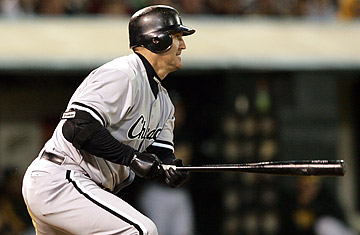
Jim Thome of the Chicago White Sox hits an RBI single against the Oakland Athletics, April 9, 2007.
Centerfield? No way — for every Andruw Jones, there's a Nook Logan (Washington Nationals) and Chris Duffy (Pittsburgh Pirates). First base? Give me Albert Pujols, you take Conor Jackson (Arizona Diamondbacks) and Casey Kotchman (Los Angeles Angels).
No, the glitziest spot in the game belongs to that much-maligned anomaly of the American League, the Designated Hitter. David Ortiz, Jason Giambi, Gary Sheffield, Sammy Sosa — the profusion of star power is terrifying news for baseball purists, who for years have griped that the DH rule, which was instituted in 1973 to spark sagging American League offenses, takes much of the strategy out of the national pastime. The usual complaint has been that with the DH, managers didn't have to pick pinch hitters, or pull off slick double switches. For years it was the home of all-or-nothing strikeout kings too bulky to play the field — think Greg "The Bull" Luzinski, the DH for the Chicago White Sox in the early 1980s, or Reggie Jackson late in his career.
But as baseball's economics thrive, more teams can afford high-profile players to fill the DH spot: the Toronto Blue Jays can sign Frank Thomas, who hit 39 home runs for Oakland last season, to a two-year, $18 million contract, and Oakland can give Mike Piazza one-year, $8.5 million deal to replace him. The result is a concentration of DH talent the game has never seen before. "It's unusual," says veteran Texas Rangers scout Mel Didier. "You usually have two or three of those Hall of Fame caliber guys, but seven or eight? No way."
And that's a good thing. It's time to stop the griping, and appreciate the DH position for featuring the game's brightest offensive talent. Though the current DHs are by no means Gold Glovers, they are no longer one-dimensional hitters. The game's current obsession with on-base percentage, driven by Oakland A's general manager Billy Beane's stat-driven Moneyball methods, demands that they hit for power and average, and draw walks. "The skill that has the longest shelf life is on-base percentage," says Beane. "And the DH allows you the opportunity to continue to use that skill."
The 2007 DH crop falls into three distinct categories. First, there are the prime-timers — Boston's David "Big Papi" Ortiz and Travis Hafner of the Cleveland Indians, who are both DH-ing at the peak of their careers. "Ortiz and Hafner are two of the best four hitters in baseball right now, by any standard that's valid," says Indians General Manager Mark Shapiro. It's hard to argue with him — Hafner, 29, hit .308 with 42 homers in 2006, and Ortiz, 31, not only led the American League with 54 home runs last season, but is by far the best clutch hitter in the game.
The pair, who have essentially been DH-ing since the start of their careers, offer a glimpse at the position's future. For years, managers were afraid to DH young players because of the pressure inherent in the position. If your job is just to hit, you'd better hit. "You're going to go with a veteran guy who can handle the pressure," says Didier. "When he sits on the bench, he's not going to want to hit the bat over his head if he goes 0 for 4. Those young guys are insecure, boy." But Hafner and Ortiz have shown that certain level-headed young players can produce, allowing their teams to put more skilled defenders on the field. And baseball teams love to copycat. "This is a generation of players that have put a lot of focus on hitting," says Beane. "So, there's no question that one of the changes we've seen is that GMs will actually see young players and go, 'yeah, that guy could be a DH.'"
Call the second DH category "the tweeners." Chicago's Jim Thome, Jason Giambi of the New York Yankees and Gary Sheffield of the Detroit Tigers are former position players in between the prime and swan song stages of their careers. But they still have plenty of pop. Thome, for example, belted 42 home runs last year, and Giambi's .413 on-base percentage was tied for sixth in the AL.
Finally, there's the trio of likely Hall of Famers on their last legs, Thomas, Piazza and Sosa, who was signed by the Texas Rangers. Piazza is a definite for Cooperstown, as one of the greatest hitting catchers (though certainly not throwers) of all time. If Thomas belts 11 more home runs and gets to 500 for his career, count him in. Only steroid whispers can keep Sosa out of the Hall. Even Fred Claire, ex-GM of the Los Angeles Dodgers and a career anti-DH National Leaguer, admits that "on the plus side of the ledger, the DH lets guys that have been great players continue to have a role. That's good for the game." And these guys aren't sad, creaky sluggers desperate to hang on. Sosa tore up spring training, Thomas hit 39 homers in '06, and Piazza belted 22 dingers while catching with the Padres last year — and already has a game-winning shot as a DH with Oakland.
So please, stop dismissing the DH. Sure, these hitters spent most of their workday on the bench spitting sunflower seeds or chewing tobacco. But what's better: watching Jim Thome bat 500 times a year, or rotund pitcher David Wells trying to sacrifice bunt with the San Diego Padres? And really, is the double switch all that exciting? (New York Mets closer Billy Wagner comes into the game — and will hit sixth in the lineup!) "It's a no-brainer," says Shapiro. So put down your gloves, kids. The DH, thank goodness, is now a genuine hit.
